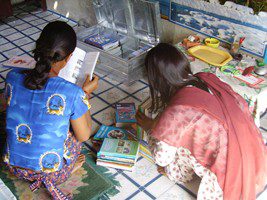21. January 2014
by Sagar Aryal
Female education has been neglected in our country since the earliest days. We find some isolated cases of women’s education in the history of our land. Homes were considered to be the field of work for women and work in other fields of activity.
“If you teach a man, you teach an individual but if you teach a woman, you teach the whole family,” goes a saying. If women are educated they will share their knowledge with everyone. They teach their children and manage their homes more effectively.
If they are active and set an example for the children and family, the future of her children would be bright. The educated women can even afford a helping hand in their own business and give her family encouragement and high spirits. Nevertheless, the traditional role of a woman gets reformed and she becomes open minded.
Looking at the numbers
According to recent reports, the Nepal Living Standards Survey 2010-2011 (NLSS- III) has found out that Nepal has an adult literacy rate of 56.6% with a huge variation between men and women. While male literacy rate is 71.6%, it is only 44.5% for women. This shows that there is still a belief among Nepalese people that girls are limited to go to schools.
Women receive only about 16% of undergraduate and 11% of doctorate degrees in engineering; less than 22% of doctorate degrees in math and physical sciences; 28% of undergraduate and 15% of doctorate degrees in computer and information sciences. By contrast, women continue to earn the largest proportion of degrees at all levels (associate through doctoral degrees) in the fields they have traditionally dominated, such as health professions which includes nursing, physical therapy and health administration (83%) and education (77%).
Some more general facts
Education system started in Nepal when Tri Chandra College was established by Chandra Shamsher and Jang Bahadur Rana in 1918, which marks the commencement of Higher Education system in Nepal. Thru 1965, there were 5 public colleges with the enrolment of 5,000 and 51 community colleges with a total enrolment of 10,000.
The education system of Nepal stands as:
- Primary Level: From Standard 1 to 5
- Lower Secondary Level: From Standard 6 to 8
- Secondary Level: Standard 9 and 10 – Class 10 is also known as SLC (School Living Certificate)
- Higher Secondary: Standard 11 and 12 ( Under Higher Secondary Education Board)
- University Level: Bachelor’s Degree / Undergraduate, Master’s Degree / Graduate, Post Graduate, M.Phil., and Ph.D.
Tribhuvan University (TU) is the 1st University of Nepal which was established in 1959 and started affiliating public colleges since 1971. Almost 87% of the student enrollments are in Education, Management and Humanities. Student enrolment in Science and Technology, Engineering and Medicine are very low. Although there has been a remarkable numerical growth in the literacy rates, as well as the number of education institutions over the years, the quality of education has not necessarily improved.
Education in 2010-2011

Table 1: Basic Data on Universities and Institution of Higher. Source: University Grant Commission (UGC)
It is clear that access to education, especially for women is still an important issue in Nepal. Hopefully the future will continue to challenge these numbers, push them to grow and open up academic opportunities to girls, women and all of Nepal as a whole.
source:https://iversity.org/blog/women-education-system-nepal/


